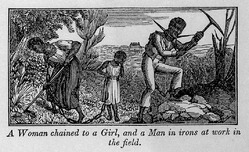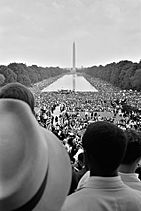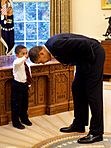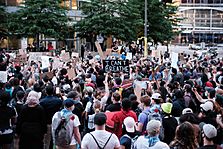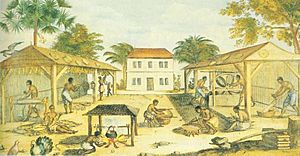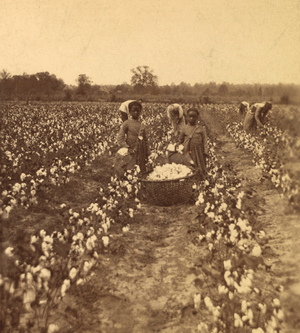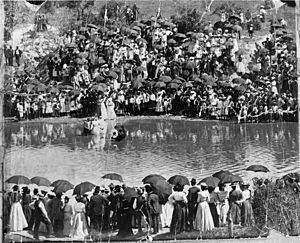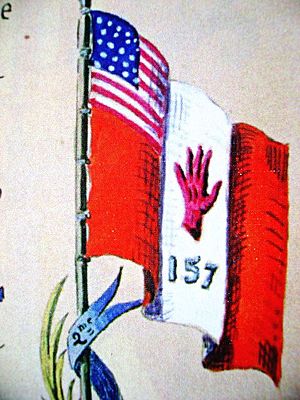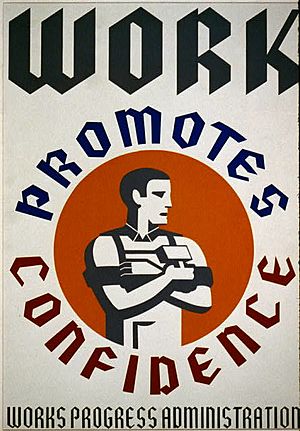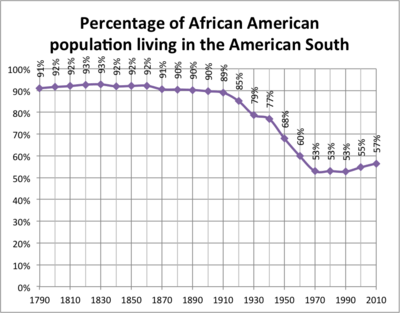African-American history facts for kids
African-American history tells the story of people of African descent in North America. It began in the 16th and 17th centuries when Africans first arrived. Many were brought by force as part of the Atlantic slave trade. About 388,000 enslaved Africans landed in North America. They were sold to European colonists, mostly to work on large farms called plantations.
In 1619, a group of enslaved Africans arrived in the English colony of Virginia. This marked the start of slavery in the colonial history of the United States. By 1776, about 20% of the population in British North America was of African descent. This included both free people and enslaved people.
The American Revolutionary War changed things for African Americans. Black soldiers fought on both the British and American sides. After the war, the Northern United States slowly ended slavery. However, the American South depended on slave labor for its farms. Slavery grew as the U.S. expanded westward. Many enslaved African Americans escaped to free states and Canada using the Underground Railroad. Disagreements over slavery led to the American Civil War. During this war, 178,000 African Americans fought for the Union. President Abraham Lincoln issued the Thirteenth Amendment, which ended slavery in the U.S.
After the war, the Reconstruction era began. African Americans in the South were given equal rights. But white people opposed these changes. Many African Americans in the South lost their right to vote. A system of racial segregation called Jim Crow laws was put in place. In the early 1900s, over 6 million African Americans moved from the South to other parts of the U.S. This was called the Great Migration. They sought better jobs and less discrimination.
Efforts to fight discrimination and racism grew into the Civil Rights Movement. Leaders like Rosa Parks and Martin Luther King Jr. led this movement. In 1964, the federal government passed the Civil Rights Act of 1964. This law made racial discrimination illegal.
The 2020 United States census reported that over 46 million people identified as African American. This is about 14.2% of the U.S. population. African Americans have greatly contributed to American culture. This includes literature, movies, and music.
Contents
- Enslavement in America
- Colonial America and Slavery
- American Revolution and Early United States
- Religion and Community
- Before the Civil War
- Civil War and Emancipation
- Reconstruction Era
- Jim Crow and Racial Terror
- Early Civil Rights Efforts
- Great Migration and Harlem Renaissance
- Black-Owned Businesses
- World War I and African Americans
- New Deal Era
- World War II and Civil Rights
- Second Great Migration
- Civil Rights Era
- After the Civil Rights Era
- Studying African-American History
Enslavement in America
African Origins of Enslaved People
Most African Americans are descendants of Africans forced into slavery. These people were captured during wars or raids in Africa. They were then bought and brought to America as part of the Atlantic slave trade. Enslaved Africans came from many different groups. Most were from Western and Central Africa. Some were from Eastern and Southeast Africa.
Major groups included the Bakongo, Igbo, Mandé, Wolof, Akan, Fon, Yoruba, and Makua. These groups had different customs, religions, and languages. But in America, they were forced to adopt European ways. They then created a new culture that blended their African past with European influences.
Where Enslaved People Came From
Studies show that enslaved Africans came from seven main regions during the Atlantic slave trade:
- Senegambia: From the Senegal River to the Casamance River.
- Sierra Leone region: From the Casamance to the Assinie. This includes modern Guinea-Bissau, Guinea, Sierra Leone, Liberia, and Côte d'Ivoire.
- Gold Coast region: Mostly modern Ghana.
- Bight of Benin region: From the Volta River to the Benue River. This includes modern Togo, Benin, and southwestern Nigeria.
- Bight of Biafra: From southeastern Nigeria through Cameroon into Gabon.
- West Central Africa: The largest region, including Congo and Angola.
- East and Southeast Africa: The Mozambique-Madagascar region. This includes modern Mozambique, parts of Tanzania, and Madagascar.
West Africa was the largest source of enslaved people for the New World. Many West Africans were skilled iron workers. They made tools for farming. While many tribes had their own customs, some had adopted Islam by the 10th century.
About 10–12 million Africans were sent to the Western Hemisphere. Most came from the West African coast. Only about 5% (500,000) went to the American colonies. The rest went to the West Indies and Brazil. In the American colonies, conditions were better. There was less disease, more food, some medical care, and lighter work.
Here's where enslaved people imported to the Thirteen Colonies, French and Spanish Louisiana came from (1700–1820):
| Region | Percentage |
|---|---|
| West Central Africa | 26.1% |
| Bight of Biafra | 24.4% |
| Sierra Leone | 15.8% |
| Senegambia | 14.5% |
| Gold Coast | 13.1% |
| Bight of Benin | 4.3% |
| Mozambique-Madagascar | 1.8% |
| Total | 100.0% |
The Middle Passage Journey
Before the Atlantic slave trade, some people of African descent were already in America. Some African countries would sell enslaved people, often prisoners of war, to Europeans. The people of Mali and Benin were known for selling their prisoners of war as slaves.
The Horrors of Transport
Olaudah Equiano described the journey on slave ships as terrible. Enslaved Africans were separated from their families before boarding. On the ships, men and women were kept apart. Below deck, they were terribly cramped. There was not enough space to move. Enslaved men were often in the ship's hold, where conditions were worst. They were pinned to the floorboards.
Lack of hygiene, poor food, and dehydration caused diseases to spread quickly. Many people died. Women and children were often kept in separate rooms. This gave crewmen easy access to the women. But it also gave enslaved women more information about the ship. For example, women started a rebellion on the slave ship Thomas in 1797. They stole weapons and passed them to the men.
Enslaved Africans often planned revolts. But these were usually unsuccessful. To keep control, crews were often twice as large. They used brutality and harsh punishments to scare the enslaved people. The journey from capture in Africa to arrival in America took about six months. Enslaved people were completely cut off from their homes and families. They were forced to adjust to a new, harsh life.
Colonial America and Slavery

Africans helped the Spanish and Portuguese explore the Americas early on. In the 1500s, some Black explorers settled in the Mississippi valley. They also settled in areas that became South Carolina and New Mexico. Estéban, a Black explorer, traveled through the Southwest in the 1530s.
In 1619, the first captive Africans arrived by a Dutch slave ship at Point Comfort in Virginia. They had been kidnapped by Portuguese slave traders. At first, Virginia settlers treated them as indentured servants. This meant they were freed after a few years. But this practice slowly changed to a system of lifelong slavery, like in the Caribbean.
This change happened for several reasons. Freed servants became competition for jobs and resources. Also, new servants were always needed. The unclear social status of Black people and the difficulty of finding other forced laborers led to Black people being enslaved. Massachusetts was the first colony to make slavery legal in 1641. Other colonies followed. They passed laws making slave status inherited. This meant children of enslaved people were also enslaved for life.
At first, white indentured servants outnumbered Africans in the South. But plantation owners needed more workers for their large farms. They turned to African slavery. Enslaved people had some legal rights. For example, killing an enslaved person was a crime. Owners were mostly interested in work output. Enslaved Africans developed their own family systems, religions, and customs. Before the 1660s, the North American colonies were small. They did not need many enslaved Africans yet.
Black Population Growth in the 1700s
By 1700, there were 25,000 enslaved Black people in the North American colonies. They made up about 10% of the population. Some had been shipped directly from Africa. Others had come through the West Indies. Many were born in North America. Their legal status was clear: enslaved for life, and their children inherited this status.
As European colonists took more land for farming, the number of enslaved Africans brought to the continent grew quickly. This started in the 1660s. The slave trade from the West Indies was not enough. Also, North American buyers preferred enslaved people directly from Africa. Most enslaved Africans imported after the 1680s came directly from Africa. They arrived in ports in what is now the Southern U.S., especially Virginia, South Carolina, Georgia, and Louisiana.
By the early 1700s, enslaved Africans had replaced indentured servants as the main labor source for Southern plantations. The enslaved African American population grew fast in the 1700s and early 1800s. This was partly due to fewer tropical diseases. People in the colonies disagreed about slavery. But it was legal in all Thirteen Colonies until the American Revolution. Slavery caused a divide between the North and South. The North was more urban and industrial. It needed fewer enslaved people than the South.
By the 1750s, more enslaved people were born in America than imported from Africa. By the American Revolution, some Northern states considered ending slavery. Some Southern colonies, like Virginia, had so many native-born enslaved people that they stopped importing them. But Georgia and South Carolina still needed a steady supply for their growing farms. They continued importing enslaved Africans until the trade was outlawed in 1808.
South Carolina's Black population was very high in the 1700s. Black people outnumbered whites three to one. Virginia, however, kept a white majority. The colony of South Carolina was said to resemble an "extension of West Africa". The legal import of enslaved Africans stopped in 1808. This was the earliest date allowed by the Constitution. But some enslaved Africans were still brought in illegally until 1859.
A free Black population slowly grew, mostly in port cities. These cities included Charleston and Boston. Enslaved people in cities had more privileges than those on plantations. But most enslaved people lived on southern tobacco or rice plantations. They usually lived in groups of 20 or more. Wealthy plantation owners became very dependent on slavery. This system would eventually divide America.
The most serious slave rebellion was the 1739 Stono Rebellion in South Carolina. About 150 enslaved people rebelled. They took guns, killed twenty whites, and fled to Spanish Florida. The local militia quickly stopped them. Most of the enslaved people involved were killed.
At this time, slavery existed in all American colonies. In the North, 2% of people owned enslaved people. Most were personal servants. In the South, 25% of the population relied on enslaved labor. Southern slavery usually involved field hands working on plantations.
American Revolution and Early United States
The late 1700s saw big political changes in North America. As colonists demanded freedom from British rule, many pointed out the contradiction. Slaveholders wanted freedom but kept others enslaved. The United States Declaration of Independence, which spoke of human rights, was written by Thomas Jefferson. He owned over 200 enslaved people. Other Southern leaders also owned many slaves. The Second Continental Congress thought about freeing enslaved people to help with the war. But they removed parts of the Declaration that criticized slavery. Free Black people, like Prince Hall, asked for slavery to end. But these requests were mostly ignored.
Despite this, Black people, both free and enslaved, joined the Revolution. Crispus Attucks, a free Black tradesman, was the first person killed in the Boston Massacre. He was also the first casualty of the American Revolutionary War. About 5,000 Black people, including Prince Hall, fought in the Continental Army. They fought alongside white soldiers at battles of Lexington and Concord and Bunker Hill. However, when George Washington became commander in 1775, he stopped recruiting Black people.
About 5,000 free African-American men helped the American Colonists. One of them, Agrippa Hull, fought for over six years. These soldiers fought to improve how white neighbors saw them. They also fought to advance their own freedom.
The British and Loyalists offered freedom to any enslaved person owned by a Patriot who joined their side. Lord Dunmore, the Governor of Virginia, recruited 300 African-American men into his Ethiopian Regiment. In South Carolina, 25,000 enslaved people escaped to fight with the British or flee for freedom. Thousands also escaped in Georgia, Virginia, New England, and New York. Famous African Americans who fought for the British include Colonel Tye and Boston King.
Thomas Peters was one of many African Americans who fought for the British. He was born in Nigeria, captured, and sold into slavery in French Louisiana. He was sold again in North Carolina. He escaped to gain the freedom Lord Dunmore promised. Peters fought for the British throughout the war. After the war, he and other African Americans who fought for the British were taken to Nova Scotia. They struggled to farm the small plots of land they received. They also did not get the same opportunities as white Loyalists. Peters sailed to London to complain to the government. He arrived when English abolitionists were creating the Sierra Leone Company. This company would grant trading and settlement rights on the West African coast. Peters and other African Americans from Nova Scotia left for Sierra Leone in 1792. Peters died soon after, but his group formed the Sierra Leone Creole ethnic identity.
American Independence and Black Rights
The colonists won the war, and the United States became an independent nation. In the peace treaty, they demanded the return of property, including enslaved people. But the British helped up to 3,000 documented African Americans leave for Nova Scotia, Jamaica, and Britain. This was to prevent them from returning to slavery.
The Constitutional Convention of 1787 set up the U.S. government. The Constitution spoke of freedom and equality. But it also allowed slavery to continue through the fugitive slave clause and the three-fifths compromise. Free Black people's rights were also limited. Many could not vote or attend public schools. Some Black people fought these issues in court. In 1780, Elizabeth Freeman and Quock Walker used the new Massachusetts constitution's language about all men being born free and equal. They won their freedom from slavery. A free Black businessman in Boston, Paul Cuffe, tried to avoid paying taxes since he could not vote.
In the Northern states, the revolutionary spirit helped African Americans. After the 1750s, many felt slavery was wrong. All Northern states passed laws to end slavery between 1780 and 1804. Most of these laws ended slavery slowly. In 1787, Congress passed the Northwest Ordinance, banning slavery in the large Northwest Territory. By 1790, there were over 59,000 free Black people in the U.S. By 1810, this number grew to 186,446. Most were in the North. But revolutionary ideas also led some Southern slaveholders to free enslaved people.
For 20 years after the Revolution, more Southerners freed enslaved people. This was sometimes done by manumission (being set free) or in wills after the owner's death. In the Upper South, the percentage of free Black people rose from about 1% before the Revolution to over 10% by 1810. Quakers and Moravians encouraged slaveholders to free families. In Virginia, the number of free Black people grew from 10,000 in 1790 to nearly 30,000 in 1810. But 95% of Black people were still enslaved. In Delaware, three-quarters of all Black people were free by 1810. By 1860, over 91% of Delaware's Black people were free, and 49.1% in Maryland.
One successful free man was Benjamin Banneker. He was a Maryland astronomer, mathematician, and surveyor. In 1791, he helped survey the boundaries of the future District of Columbia. Despite challenges, most free Black people lived better than the nearly 800,000 enslaved Black people. Still, many thought about moving to Africa.
Religion and Community
By 1800, a small number of enslaved people had joined Christian churches. Free Black people in the North created their own churches. In the South, enslaved people sat in the upper sections of white churches. The Black church became very important for Black communities. It was often the first community group formed. The Black church showed unique African-American spirituality. It also was a response to discrimination. Churches served as neighborhood centers. Here, free Black people could celebrate their African heritage without white interference. Churches also helped with education. They educated both freed and enslaved Black people. Some Black people, like Richard Allen (bishop), started separate Black church groups to gain independence.
The Second Great Awakening (1800–1830s) was a major event for the growth of Afro-Christianity.
Before the Civil War
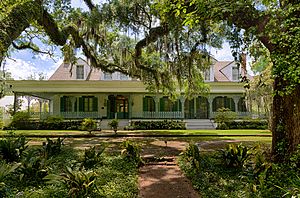
As the United States grew, slavery became stronger in the southern states. But northern states began to abolish it. Pennsylvania was the first, passing a law for gradual abolition in 1780.
The Haitian Revolution also shaped views on slavery. This was the only slave revolt that led to an independent country. Many slave owners fled to the U.S. They told horror stories that worried Southern whites.
The invention of the cotton gin in the 1790s changed everything. It made it easy to grow short-staple cotton in the Deep South. The industrial revolution in Europe and New England created a huge demand for cotton. This led to a massive demand for slave labor to work on new cotton plantations. The number of enslaved people in the U.S. increased by 70% in just 20 years. They were mostly on plantations in the Deep South. They moved west as old cotton fields became less productive. Unlike the North, which focused on factories, the South relied heavily on farming. Southern thinkers supported slavery. They believed it was necessary for their economy. Racial, economic, and political tensions over slavery grew very high before the Civil War.
In 1807, President Thomas Jefferson urged Congress to stop importing enslaved workers. Black Americans saw this as a victory. But it increased the internal trade of enslaved people within the U.S. Changes in farming in the Upper South meant less need for labor. So, enslaved people were sold to traders in the developing Deep South. Also, the Fugitive Slave Act of 1793 allowed any Black person to be claimed as a runaway. This was unless a white person spoke for them. Many free Black people, especially children, were kidnapped and sold into slavery. By 1819, there were 11 free states and 11 slave states. This increased sectionalism (division between regions). Fears of an imbalance in Congress led to the 1820 Missouri Compromise. This law required states to join the Union in pairs: one slave state and one free state.
In 1850, after the Mexican–American War, the nation faced a problem. What to do with the new territories from Mexico? Henry Clay, who helped with the 1820 compromise, created the compromise of 1850. New Mexico, Arizona, Utah, and Nevada would be organized, but slavery would be decided later. Washington D.C. would end the slave trade, but not slavery itself. California would join as a free state. But the South got a new fugitive slave act. This law required Northerners to return enslaved people who escaped to the North. The Compromise of 1850 kept a shaky peace until Lincoln's election in 1860.
In 1851, a conflict between enslaved people and slave owners happened in Lancaster County, Pennsylvania. The Christiana Riot showed the growing fight between states' rights and Congress over slavery.
Abolitionism: Fighting Slavery
Abolitionists in Britain and the United States created large campaigns against slavery from 1840 to 1860.
Black people were the most powerful abolitionist speakers. They spoke at many meetings of the National Negro Conventions. They argued against slavery based on morals, economics, and politics. Their role helped the abolitionist cause and made the Black community proud.
In 1852, Harriet Beecher Stowe published Uncle Tom's Cabin. This novel changed how many people saw slavery. It told the story of an enslaved person's life and the brutality they faced. It sold over 100,000 copies in its first year. The book made the North stronger in its opposition to slavery. It pushed the abolitionist movement forward. President Lincoln later invited Stowe to the White House because of her book.
In 1856, Charles Sumner, an antislavery leader, was attacked in Congress. Preston Brooks of South Carolina nearly killed him. Sumner was giving an abolitionist speech when Brooks attacked him. Brooks was praised in the South. Sumner became a hero in the North. Sumner later returned to the Senate. He led the Radical Republicans in ending slavery and making laws for equal rights for freed slaves.
Over 1 million enslaved people were moved from older slave states to the cotton states of the southwest. Many others were sold locally. Historian Ira Berlin (2000) says this "Second Middle Passage" showed enslaved people that owners were not truly caring. This led enslaved and free Black people to create ways to resist. These ways helped them deal with constant forced moves and flights. Benjamin Quarles' book Black Abolitionists describes the important role of Black abolitionists.
The Black Community Grows
Black people often settled in cities. This became the center of Black community life. They started churches and social groups. Many early efforts were small, but they were the first steps in building Black communities.
During the early period before the Civil War, free Black communities grew. At first, only a few thousand African Americans were free. But by the 1820s, this number grew to 233,000. They sometimes sued for freedom or bought it. Some slave owners freed their enslaved people. A few states ended slavery.
African Americans tried to find homes and jobs in cities. In the early 1800s, free Black people worked to build good lives in urban areas. Factories, which used machines more than human labor, might have offered jobs. But many factory owners refused to hire Black workers. They thought white workers were more reliable. So, many Black people did unskilled labor. Black men worked as stevedores (loading ships), construction workers, and grave-diggers. Black women worked as servants for white families. Some women were also cooks, seamstresses, basket-makers, midwives, teachers, and nurses.
While many free Black people lived in poverty, some started successful businesses for the Black community. Racial discrimination often meant Black people were not welcome in white businesses. To fight this, Black people like James Forten built their own communities with Black-owned businesses. Black doctors, lawyers, and other business owners formed the start of the Black middle class.
Many Black people organized to strengthen their community and fight slavery. One group was the American Society of Free Persons of Colour, founded in 1830. This group helped poor Black people and responded to political issues. The Black church also supported community growth. It was usually the first community group formed. Starting in the early 1800s with the African Methodist Episcopal Church and others, the Black church became the center of the Black community. It was a place for unique African-American spirituality and a response to discrimination. Churches also served as neighborhood centers where free Black people could celebrate their heritage. The church was also a center for education. It educated freed and enslaved Black people. Because of discrimination in white churches, some Black people like Richard Allen (bishop) started separate Black church groups.
Free Black people also started Black churches in the South before 1800. After the First Great Awakening, many Black people joined the Baptist Church. This church allowed them to participate, even as preachers. For example, First Baptist Church and Gillfield Baptist Church in Petersburg, Virginia, had organized Black groups by 1800. Petersburg had the largest free Black population in the South by 1860. In Virginia, free Black people also created communities in Richmond, Virginia and other towns. Here, they could work as artisans and start businesses. Others bought land and farmed in frontier areas, away from white control.
The Black community also started schools for Black children. This was because they were often banned from public schools. Richard Allen started the first Black Sunday school in America in Philadelphia in 1795. Five years later, Absalom Jones started a school for Black youth. Black Americans saw education as the best way to succeed, improve themselves, and find happiness. But only children of the Black middle class could usually afford to study.
Haiti's Influence on Slavery
The revolt of enslaved Haitians against their white slave owners began in 1791 and lasted until 1801. This revolt greatly inspired enslaved people and abolitionists in the U.S. In 1833, Nile's Weekly Register said that freed Black people in Haiti were better off than those in Jamaica. It also hinted at the positive effects of American emancipation. These anti-slavery ideas were popular among white abolitionists and enslaved African Americans. Enslaved people used these ideas to fuel rebellions. Examples include the Denmark Vesey Conspiracy of 1822 and the Nat Turner Rebellion of 1831. Leaders and plantation owners were also worried about Haiti's revolution. Thomas Jefferson, for example, was concerned about the "instability of the West Indies," referring to Haiti.
Dred Scott Decision
Dred Scott was an enslaved man whose owner took him to live in the free state of Illinois. After his owner died, Dred Scott sued for his freedom. He argued that he should be free because he had lived in a free state. The Black community was shocked by the Supreme Court's "Dred Scott" decision in March 1857. The court said Black people were not American citizens and could never be citizens. The Republican Party and abolitionists strongly criticized this decision. The court also said enslaved people were "property, not people." So, they could not sue in court. This decision was finally overturned by the Civil Rights Act of 1865. The Fourteenth Amendment in 1868 also stated that "All persons born or naturalized in the United States...are citizens of the United States."
Civil War and Emancipation
The Emancipation Proclamation was an order from President Abraham Lincoln. He issued it on January 1, 1863. This order changed the legal status of 3 million enslaved people in Confederate areas from "slave" to "free." This meant that as soon as an enslaved person escaped or was reached by Union troops, they became free. Owners were not paid for their loss. Plantation owners knew emancipation would ruin their economy. They sometimes moved their enslaved people far from the Union army. By June 1865, the Union Army controlled all of the Confederacy. They freed all the enslaved people.
About 200,000 free Black people and former enslaved people served in the Union Army and Navy. This helped them claim full citizenship. The war and Reconstruction caused many problems for the Black population. There was much sickness and death.
Reconstruction Era
The Civil Rights Act of 1866 made Black people full U.S. citizens. This overturned the Dred Scott decision. In 1868, the 14th Amendment gave full U.S. citizenship to African Americans. The 15th Amendment, passed in 1870, gave Black men the right to vote. The Freedmen's Bureau was important. It helped create social and economic order in Southern states.
After the Union won the Civil War, a period of progress for Southern Black people began. This was called Reconstruction. During Reconstruction, states that had left the Union rejoined it. From 1865 to 1877, with Union troops protecting them, African Americans made progress toward equal rights. Southern Black men began to vote. They were elected to the United States Congress and local offices. But the safety from troops did not last long. White Southerners often terrorized Black voters.
Groups of white and Black Republicans created the first public school systems in most Southern states. But it was hard to find enough money. Black people started their own churches, towns, and businesses. Tens of thousands moved to Mississippi. They hoped to clear and own their own land. By the late 1800s, two-thirds of the farmers who owned land in the Mississippi Delta were Black.
Hiram Rhodes Revels became the first African-American senator in the U.S. Congress in 1870. Other African Americans soon joined Congress from South Carolina, Georgia, Alabama, and Mississippi. These new politicians supported Republicans. They tried to improve life for African Americans. Revels understood that white people might feel threatened. He said, "The white race has no better friend than I. I am true to my own race. I wish to see all done that can be done...to assist [Black men] in acquiring property, in becoming intelligent, enlightened citizens...but at the same time, I would not have anything done which would harm the white race." Blanche Bruce was another African American who became a U.S. senator during this time. He worked with white politicians to help African Americans and other minority groups.
The Civil War's end sped up the creation of a national African American identity. Some civil rights activists, like W. E. B. Du Bois, disagreed that identity was fully achieved. After the Civil War, African Americans faced many rules. Even though they were "free," these rules stopped them from having the same freedom as white citizens. Tens of thousands of Black Northerners moved to the South. They built schools, printed newspapers, and opened businesses. As Joel Williamson said, many came as teachers, relief workers, or missionaries. Others came as business people seeking opportunities. Thousands also came as soldiers and stayed in the South.
Jim Crow and Racial Terror
The Jim Crow laws were state and local laws in the U.S. They were passed between 1876 and 1965. They forced segregation in all public places. Black Americans were supposedly "separate but equal." But in reality, their facilities were always worse than those for white Americans. This created many economic, educational, and social disadvantages.
White violence and threats against Black people grew. The U.S. government stopped protecting freedmen and women. When President Rutherford B. Hayes removed Union troops from the South in 1877, Black people lost most of their political power. Men like Benjamin "Pap" Singleton began talking about leaving the South. This led to the 1879–80 movement of the Exodusters. They moved to Kansas, where Black people had more freedom and could buy land more easily.

When Democrats took control of Tennessee in 1888, they made voter registration harder. This ended fair elections in the state. Voting by Black people in rural areas dropped sharply. Voting by poor whites also dropped.
From 1890 to 1908, ten of eleven Southern states adopted new constitutions or changes. These laws effectively stopped most Black people and many poor whites from voting. They used things like poll taxes, residency rules, and literacy tests. States greatly reduced Black voter registration and turnout. The grandfather clause temporarily allowed illiterate white voters to avoid literacy tests. As the Democratic Party gained power in the South, it acted like a private club. It created white primaries, which kept Black people out of elections. By 1910, one-party white rule was strong across the South.
African Americans quickly challenged these laws in court. But early court decisions went against them. In Williams v. Mississippi (1898), the U.S. Supreme Court upheld these state laws. This encouraged other Southern states to pass similar laws. Booker T. Washington secretly worked with Northern supporters. He raised money and provided lawyers for African Americans in cases like Giles v. Harris (1903). But the Supreme Court still supported the states.
Segregation became a legal process in the South. It was informal in Northern cities. Jim Crow laws limited Black access to transportation, schools, restaurants, and other public places. Most Southern Black people struggled in poverty for decades. They worked as farm laborers, house servants, and low-wage workers. Many became sharecroppers, sharing their crops with white landowners.
Racial Terrorism and Violence
In 1865, the Ku Klux Klan was formed. This was a secret white supremacist criminal group. It aimed to destroy the Republican Party in the South. It especially targeted Black leaders through terror. Klansmen wore masks and robes to hide their identities. They used violence, murder, threats, arson, and intimidation. Laws were passed against the Klan. With federal enforcement, it was destroyed by 1871.
But anti-Republican and anti-freedmen violence continued. This was especially true after Louisiana's disputed election in 1872. This led to the Colfax and Coushatta massacres in Louisiana in 1873 and 1874. Tensions were high in many parts of the South. When violence broke out, African Americans were killed at a much higher rate than white Americans. Historians now call many events once called "riots" by Southern history "massacres." This is because of the much higher number of Black deaths.
Other paramilitary organizations appeared in the South in the mid-1870s. These groups were more organized than the Klan. They openly challenged Republican governments. They stopped Black people from voting to regain power in 1876. Groups included the White League, the Red Shirts, and other White Line groups.
The Jim Crow era brought the cruelest period of racial oppression in America. Between 1890 and 1940, millions of African Americans lost their right to vote. Many were killed and brutalized.
Of the tens of thousands of people who participated in lynchings, fewer than 50 white people were ever charged. Only four were sentenced. Because Black people could not vote, they could not serve on juries or hold local offices. Lynchings were used as a weapon of terror. They kept millions of African Americans living in constant fear. Most Black people were denied their right to keep and bear arms under Jim Crow laws. So, they could not protect themselves or their families.
Early Civil Rights Efforts
In response to these problems, W. E. B. Du Bois and 28 other important African-American men met secretly in 1905. They met at Niagara Falls, Ontario. They wrote a statement calling for an end to racial discrimination. They demanded full civil rights for African Americans. The group they formed was called the Niagara Movement. After the Springfield, Illinois race riot of 1908, white people joined the Niagara Movement leaders. They formed the National Association for the Advancement of Colored People (NAACP) in 1909. Under Du Bois's leadership, the NAACP challenged segregation in courts. They also worked with lawmakers for Black Americans.
While the NAACP used the courts, African Americans also helped themselves locally. They combined their money to create their own communities and institutions. They built schools, churches, social welfare groups, banks, African-American newspapers, and small businesses. These served their communities. The main organizer of national and local self-help groups was Alabama educator Booker T. Washington.
Progressive Era reformers often cared about the Black condition. In 1908, after the 1906 Atlanta Race Riot, Ray Stannard Baker wrote Following the Color Line. This was the first major book by a journalist to examine America's racial divide. It was very successful. Sociologist Rupert Vance called it the best account of race relations in the South at that time.
Great Migration and Harlem Renaissance

In the first half of the 20th century, the largest movement of people in U.S. history happened. Starting around 1910, over five million African Americans moved from the South. They moved to northern and western cities. They hoped to escape discrimination, violence, and find better jobs. They also wanted to vote and get better education for their children. This was called the Great Migration.
In the 1920s, many Black people lived in New York. This led to the Harlem Renaissance. This was a cultural movement that spread nationwide. Black thinkers like Aimé Césaire celebrated Blackness. Arts and literature thrived. Writers like Zora Neale Hurston and Langston Hughes became famous. Artists like Lois Mailou Jones also gained recognition.
The South Side of Chicago also became a Black cultural center. It had many flourishing businesses, music, arts, and food. New African-American political leaders and groups emerged. These included Congressman William Dawson. NAACP membership grew quickly. It started an anti-lynching campaign. Marcus Garvey's Universal Negro Improvement Association and African Communities League, the Nation of Islam, and A. Philip Randolph's Brotherhood of Sleeping Car Porters all gained support among urban African Americans.
Black-Owned Businesses
Local businesses included beauty shops, barber shops, and funeral parlors. Booker T. Washington organized them nationally into the National Negro Business League. Ambitious Black business owners moved to large cities. They sent their children to Black colleges like Howard and Morehouse. By the 1970s, these graduates were hired by major national companies. They were active in groups like the Urban League and the NAACP.
Women in the Beauty Business
While most famous African-American businesses were owned by men, women played a big role in beauty. Black communities had their own beauty standards, focusing on hair care. Beauticians could work from home. So, many Black beauticians were in the rural South. They were pioneers in using cosmetics. Blain Roberts showed that beauty shops offered a place for clients to feel pampered. Beauty contests started in the 1920s. In the Black community, they grew from high school and college homecoming events. The most famous business owner was Madame C. J. Walker (1867–1919). She built a national business based on her invention of the first successful hair straightening process.
World War I and African Americans

Black Soldiers in WWI
The U.S. armed forces were segregated during World War I. Still, many African Americans eagerly volunteered to join the Allied cause. Over two million African American men signed up for the draft. By November 1918, over 350,000 African Americans had served with the American Expeditionary Force in France.
Most African American units were given support roles. They did not see combat. But African Americans played an important part in the war. Four African American regiments were put into French units. This was because the French needed more soldiers. One famous unit was the 369th Infantry Regiment, known as the "Harlem Hellfighters." They were on the front lines for six months, longer than any other American unit. 171 members of the 369th received the Legion of Merit.
From May to November 1918, the 371st and 372nd African American Regiments fought with the French. They earned glory in France. Both regiments were honored by the French Croix de Guerre for their bravery in the Meuse-Argonne Offensive.
Corporal Freddie Stowers of the 371st Infantry Regiment was given the Medal of Honor after his death. He was the only African American to receive it for actions in World War I. In France, Stowers led an attack on German trenches. He kept leading his men even after being wounded twice. Stowers died, but his men continued fighting and defeated the German troops.
Stowers was recommended for the Medal of Honor soon after his death. But the Army said the nomination was lost. Many believed it was ignored due to racism in the Armed Forces. In 1990, Congress pushed for an investigation. The Army approved the award. On April 24, 1991, 73 years after he died, Stowers' two sisters received the Medal of Honor from President George H. W. Bush.
Home Front and Postwar Changes
During World War I, there was a huge demand for workers in defense industries. Immigration from Europe was cut off. So, many underemployed farmers from the South were needed. Hundreds of thousands of African Americans moved to Northern industrial cities. This was part of the Great Migration. Migrants to Pittsburgh faced discrimination and limited job chances. But Pittsburgh's Black population grew from 6,000 in 1880 to 27,000 in 1910. Many got high-paying, skilled jobs in steel mills.
Historian Joe Trotter explained that African Americans used family and friend networks to help with the move. They formed migration clubs, pooled money, and moved in groups. They gathered information and discussed the pros and cons of moving North.
After the war, tensions were high. There were strikes and race riots in major cities. The summer of 1919 was called the Red Summer. About 1,000 people were killed in racial violence across the nation, mostly Black people.
However, the new Black communities in the North mostly survived. Joe Trotter explained how Black people built new institutions in places like Pittsburgh. These included Black churches, social groups, newspapers like the Pittsburgh Courier, and organizations like the NAACP.
New Deal Era
The Great Depression hit Black America hard. In 1930, four out of five Black people lived in the South. Their average life expectancy was 15 years less than whites. The Black infant death rate was twice that of whites. In Chicago, Black people were 4% of the population but 16% of the unemployed. In Pittsburgh, they were 8% of the population but 40% of the unemployed. A journalist reported in 1934 that she saw "half-starved Whites and Blacks struggle in competition for less to eat than my dog gets at home." She also said most Southern Black sharecroppers lived in conditions very close to slavery.
The New Deal did not have special programs just for Black people. But it tried to include them in all relief programs. Important agencies included the CCC for young men (in segregated units). The FERA helped with relief programs (run by local towns). The WPA employed 2 million or more workers nationwide. All races had the same wages and working conditions in the WPA.
Another federal agency was the Public Works Administration (PWA). It was led by civil rights activist Harold L. Ickes. It set goals for private companies to hire skilled and unskilled Black people for PWA projects. This helped Black people get jobs in construction. For example, Black people made up 13% of unskilled PWA jobs in Chicago.
An immediate result was a shift in Black votes in Northern cities from Republicans to Democrats. In Southern states, few Black people voted. But Black leaders used the chance to work in new federal agencies. They became social workers and administrators. They aimed to prepare a new generation of leaders for future civil rights efforts. President Franklin D. Roosevelt appointed the first Black federal judge, William H. Hastie. He also created an unofficial "black cabinet" led by Mary McLeod Bethune to advise him. Roosevelt ordered federal agencies not to discriminate against Black Americans. His wife, Eleanor Roosevelt, was very supportive of African Americans.
In Chicago, the Black community had supported Republicans. But during the Great Depression, they moved to the Democratic Party. The New Deal offered relief programs. The city's Democratic Party offered positions to leaders like William Dawson, who went to Congress.
Activists demanded a federal anti-lynching bill. But President Roosevelt knew it would not pass Congress. It would also divide his New Deal supporters. Southern white politicians voted as a bloc for the Democratic Party. This pulled the national Democratic Party to the right. Southern politicians had powerful positions in Congress. When a Black minister gave the opening prayer at the Democratic National Convention in 1936, Senator Ellison D. Smith walked out. He yelled, "This mongrel meeting ain't no place for a white man!" Other Southern Democrats also showed their displeasure to Roosevelt. But in the 1936 election, African Americans who could vote overwhelmingly voted for Roosevelt. This was the first time a Democratic presidential candidate won the Black vote.
In November 1936, the American duo Buck and Bubbles were the first Black people to appear on television. This was on a British channel.
In April 1937, Congressman Earl C. Michener read a detailed account of the lynching of Roosevelt Townes and Robert McDaniels in Congress. He introduced an anti-lynching bill. It passed the House but was stopped in the Senate by Southern senators. Civil rights leaders and Eleanor Roosevelt urged President Roosevelt to support the bill. But his support was weak. Roosevelt told Walter Francis White of the NAACP that he supported it personally. But he said, "I did not choose the tools with which I must work...If I came out for the antilynching bill now, they will block every bill I ask Congress to pass to keep America from collapsing."
Roosevelt was sympathetic, and his wife even more so. But the power of Southern Democrats in Congress limited his options. Roosevelt supported the Fair Labor Standards Act of 1938. This law set a national minimum wage of 40 cents per hour and a 40-hour work week. It also banned child labor. This was meant to help poorer Americans. Southern politicians strongly opposed it. They saw it as an attack on their way of life, which relied on very low wages. In 1938, conservative Southern Democrats allied with conservative Republicans. This alliance limited Roosevelt's ability to pass liberal laws.
After Congress passed the Selective Service Act in September 1940, A. Philip Randolph's union called for the military to end segregation. Randolph met with Roosevelt. They agreed to cancel a planned civil rights march in Washington D.C. in exchange for Executive Order 8802. This order banned discrimination in factories making weapons for the military. Roosevelt argued he could not upset powerful Southern Democrats by desegregating the military. But he could ban discrimination in factories, many of which were outside the South.
Cotton Farming and the New Deal
The largest group of Black people worked on cotton farms in the Deep South. They were sharecroppers or tenant farmers. A few owned their farms. Many white people were also tenant farmers and sharecroppers. Tenant farming was common for cotton and tobacco after the Civil War. When the economy crashed in the early 1930s, all farmers were hurt. Tenant farmers and sharecroppers were hit hardest.
The New Deal tried to raise farm prices by cutting production. The AAA paid landowners to not grow cotton or tobacco on some of their land. By law, they had to pay a portion of this money to their tenant farmers and sharecroppers. But some owners cheated. However, for most tenants and sharecroppers, the AAA helped a lot. Landowners often let their tenants use the unused land to grow food for themselves. This improved their living standards. Also, tenants and sharecroppers tended to stay with the same landowner more often. Researchers found that "planters seem to prefer Negroes to whites as tenants and coppers."
After 1945, machines were used more in cotton farming. This meant fewer tenants and sharecroppers were needed. They moved to towns and cities.
World War II and Civil Rights
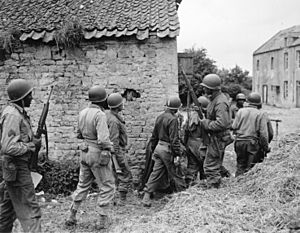
The "Double Victory" Call
The African-American newspaper Pittsburgh Courier called for a "double victory" campaign in 1942. It said all Black people should work for "victory over our enemies at home and victory over our enemies on the battlefield abroad." The newspaper argued that winning against fascism abroad and racism at home was important. This "double victory" slogan became popular among African Americans during the war.
Black Service in WWII
Over 1.9 million Black people served in uniform during World War II. They served in segregated units. Black women served in the Army's WAAC and WAC.
The draft showed the poor living conditions of most African Americans. 46% of Black men called up were rejected for health reasons. This was compared to 30% of white men. At least a third of Black men from the South were illiterate. Black men from the South scored poorly on Army tests. This was due to the lack of education for African Americans in the South. The Army had to offer special classes for them. By 1945, about 150,000 Black men learned to read and write in the Army. The Army also did health work to help soldiers.
Most Army training camps were in the South. Black people from outside the South found life there very hard. Tensions at army and navy bases led to racial violence. In the Battle of Bamber Bridge in 1943, a shootout between white and Black soldiers left one dead. To solve this, the War Department made a propaganda film called The Negro Soldier.
The segregated 92nd Division in Italy had problems between its white officers and Black soldiers. The segregated 93rd Division in the Pacific did "mopping up" duties. Black servicemen disliked segregation. Those in Europe complained that German prisoners of war got better food.
The Navy was also segregated. Black sailors usually did manual labor. At Port Chicago in 1944, an explosion killed 320 men, 202 of whom were Black. The explosion was blamed on lack of training for Black stevedores. 50 survivors refused to return to work without safety training. Their lawyer, Thurgood Marshall, argued that Black sailors were only assigned to dangerous loading jobs. He questioned why they were segregated and not promoted. Though the sailors were convicted, the Port Chicago disaster led the Navy to allow Black sailors to serve alongside white sailors in August 1944.
The Army was slow to send Black units into combat. But famous segregated units like the Tuskegee Airmen and the U.S. 761st Tank Battalion proved their bravery. About 75% of the truckers for the Red Ball Express were African-American. They kept Allied supply lines open. During the Battle of the Bulge in 1944, the Army allowed some integrated platoons. This showed that integration did not harm military discipline. This was a factor in later desegregation. A total of 708 African Americans died in combat during World War II.
The brave service of these units led President Harry S. Truman to order an end to discrimination in the Armed Forces in July 1948. This led to the integration of the Air Force and other services by the early 1950s. Walter Francis White of the NAACP wrote that World War II made Black people more aware of American democracy's promises. He believed Black veterans would return determined to improve their lives.
Home Front During WWII
Due to huge shortages during World War II, defense employers went to the South. They convinced Black and white people to move North and West for higher wages. African Americans left the South in large numbers. This sparked the Second Great Migration. They moved to cities to work in defense industries. While conditions were better (they could vote, children had better schools), they still faced discrimination. This was due to prejudice and fear of job competition from white residents.
President Roosevelt learned that many defense companies were not following Executive Order 8802. They hired Black people only for low-level jobs. He strengthened the Fair Employment Practice Committee (FEPC). It could fine companies that did not treat Black employees equally. In 1943, Roosevelt gave the FEPC a large budget. He hired staff to inspect factories. He wanted Black men and women to get skilled, high-paying jobs. This would create a Black middle class. Roosevelt also stopped unions that pushed for Black employees to get only "auxiliary" jobs. In 1944, when a union went on strike to protest hiring African Americans as trolley drivers, Roosevelt sent in troops to break the strike. In 1942, Black people were 3% of the defense workforce. By 1945, they were 8% (Black people were 10% of the population).
Racial tensions were high. Cities like Chicago, Detroit, Los Angeles, and Harlem had race riots in 1943.
Politically, Black people left the Republican Party. They joined President Franklin D. Roosevelt's Democratic New Deal Coalition. They greatly admired him. Black leaders, ministers, and newspaper editors supported the Double V campaign. This meant victory over fascism abroad and victory over discrimination at home. Black newspapers created this campaign to boost Black morale. During the war, the NAACP grew tenfold. The new civil rights group Congress of Racial Equality (CORE), founded in 1942, started protests. They demanded an end to segregation on buses, in theaters, and restaurants. In 1944, a CORE protest outside a segregated restaurant in Washington, D.C., had signs saying, "We Die Together, Let's Eat Together." In 1944, Swedish economist Gunnar Myrdal wrote An American Dilemma. He described the effects of white supremacy. He predicted that the Jim Crow system could not last. He argued that after the war, African Americans would not accept being second-class citizens.
Most Black women were farm laborers or house servants before the war. Despite discrimination in the South, they left farms for factory jobs in cities. Working with federal agencies and unions, these Black women fought a Double V campaign. They fought against the Axis abroad and against unfair hiring at home. Their efforts changed what citizenship meant. They linked their patriotism to war work. They sought equal jobs, government benefits, and better working conditions as full citizens. In the South, Black women worked in segregated jobs. In the West and North, they were integrated. But strikes happened in Detroit, Baltimore, and Evansville. White migrants from the South refused to work with Black women. The largest "hate strike" was by white women at a factory in Baltimore. They objected to sharing a bathroom with Black women.
Hollywood and Black Actors
Stormy Weather (1943), starring Lena Horne and Bill "Bojangles" Robinson, and Cabin in the Sky (1943), starring Ethel Waters and Lena Horne, opened new roles for Black people in Hollywood. These musicals broke old stereotypes. They offered much better roles than the limited, low-paying parts in movies made only for Black audiences.

Second Great Migration
The Second Great Migration was when over 5 million African Americans moved from the South. This happened from 1941, during World War II, until 1970. It was larger and different from the first Great Migration (1910–1940).
In this migration, more than five million African Americans moved to cities in the Northeast, Midwest, and West. Many skilled jobs in the defense industry were in these areas. More of these migrants were already city workers from the South. They were better educated and had more skills.
Compared to earlier migrants, many African Americans in the South already lived in cities. They had urban job skills before moving. They moved for jobs in growing industrial cities, especially defense jobs during World War II. Workers who had been limited to low-skilled jobs in Southern cities got highly skilled, well-paid jobs in West Coast shipyards. Racially similar communities formed in destination cities. These communities were influenced by the Southern culture they brought. Food, music, and even the presence of discriminatory white police were brought from their collective experiences. Writers often thought Southern migrants caused changes in the African-American family in inner cities. However, census data shows these families actually had more traditional patterns. More children lived with two parents, and fewer mothers were never married.
By the end of the Second Great Migration, African Americans mostly lived in cities. Over 80% lived in cities. 53% remained in the Southern United States. 40% lived in the Northeast and North Central states, and 7% in the West.
Civil Rights Era
The Supreme Court made a major decision in Brown v. Board of Education (1954). This decision applied to public facilities, especially public schools. Changes happened slowly. They only came after strong efforts by African Americans. The ruling also gave new energy to the Civil Rights Movement. Boycotts against segregated public transportation started in the South. The most famous was the Montgomery Bus Boycott.
Civil rights groups like the Southern Christian Leadership Conference (SCLC) organized across the South. They used boycotts, voter registration drives, Freedom Rides, and other nonviolent actions. These included marches, pickets, and sit-ins. They aimed for equal access and voting rights. Southern segregationists fought back. The conflict grew, with increasing violence, bombings, and threats from Southern whites. Law enforcement used batons, electric cattle prods, fire hoses, attack dogs, and mass arrests against protesters.
In Virginia, state officials tried to stop integration. This was called Massive Resistance. They stopped funding integrated schools. Instead, they funded private "segregation academies" for white students. Farmville, Virginia, was one of the Black communities in the 1954 Brown v. Board of Education case. To avoid court-ordered desegregation, officials in Prince Edward County closed all public schools in 1959. They stayed closed for five years. White students went to private schools. But most of the county's over 2,000 Black children, and many poor whites, had no schooling. Federal court action finally forced the schools to reopen five years later.

A high point of the Civil Rights Movement was the 1963 March on Washington for Jobs and Freedom. Over 250,000 marchers came to the Lincoln Memorial in Washington, D.C.. They spoke out against Southern racial violence and police brutality. They demanded equal job opportunities, and equal access to education and public places. The march organizers were called the "Big Six": Bayard Rustin, A. Philip Randolph, Roy Wilkins, Whitney Young, Martin Luther King Jr., James Farmer, and John Lewis. Dorothy Height also played an active role. At this event, King gave his famous "I Have a Dream" speech.
This march, the 1963 Birmingham Children's Crusade, and other events put pressure on Presidents John F. Kennedy and Lyndon B. Johnson. This led to the Civil Rights Act of 1964. This law banned discrimination in public places, jobs, and labor unions.
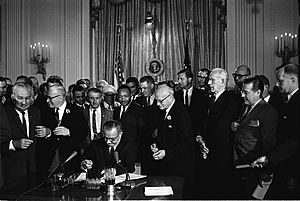
The "Mississippi Freedom Summer" of 1964 brought thousands of young people, Black and white, to the state. They ran "freedom schools" to teach reading, history, and civics. Other volunteers helped register voters. This time was marked by harassment, threats, and violence against civil rights workers. Three young people, James Chaney, Andrew Goodman, and Michael Schwerner, disappeared in Philadelphia, Mississippi. Six weeks later, their bodies were found. Chaney, a Black man, had been beaten. His two white companions had been shot. This caused national outrage.
In 1965, the Selma Voting Rights Movement and related murders inspired President Lyndon B. Johnson. He called for the Voting Rights Act of 1965. This law removed barriers to Black voting. In 1966, the Chicago Open Housing Movement led to the 1968 Fair Housing Act. This was a major achievement of the civil rights movement.
By this time, some African Americans questioned nonviolent protest. More militant Black leaders, like Malcolm X of the Nation of Islam and Eldridge Cleaver of the Black Panther Party, called for Black people to defend themselves, using violence if needed. From the mid-1960s to mid-1970s, the Black Power movement urged African Americans to look to Africa for inspiration. It emphasized Black unity over integration.
After the Civil Rights Era
African Americans have made great political and economic progress since the Civil Rights Era. Civil rights leader Jesse Jackson ran for president in 1984 and 1988. He brought huge support and influence to Black people in politics.
In 1989, Douglas Wilder became the first African-American elected governor in U.S. history. In 1992, Carol Moseley Braun of Illinois became the first Black woman elected to the U.S. Senate. In 2000, there were 8,936 Black officeholders in the U.S. In 2001, there were 484 Black mayors.
The 39 African-American members of Congress form the Congressional Black Caucus. This group works on issues important to African Americans. Black people have also been appointed to high federal offices. These include General Colin Powell, Condoleezza Rice, Ron Brown, and Supreme Court justices Thurgood Marshall and Clarence Thomas. This shows the growing presence of Black people in politics.
Economic progress for Black people reaching extreme wealth has been slow. Oprah Winfrey was the richest African American of the 20th century. She was the world's only Black billionaire in 2004, 2005, and 2006. She has been the only Black person on the Forbes 400 list almost every year since 1995. BET founder Bob Johnson was briefly a billionaire. With Winfrey being the only African American on the Forbes 400 list, Black people make up 0.25% of America's richest, while being 13% of the U.S. population.
A major political breakthrough came in 2008. Barack Obama, whose father was Kenyan and mother was white American, was elected president. He received huge support from African-American voters. African Americans continued to support Obama throughout his time in office. In 2012, he was re-elected president.
The post-civil rights era is also known for the New Great Migration. Millions of African Americans have returned to the South. This includes Texas, Georgia, Florida, and North Carolina. They often seek better economic opportunities in now-desegregated Southern cities.
On August 11, 2020, Kamala Harris was announced as the first African-American woman to run for vice-president on a major party ticket. She was elected vice president in the 2020 United States presidential election.
Social Issues Today
After the Civil Rights Movement gains of the 1950s–1970s, African-American communities faced new challenges. Due to government neglect, poor social policies, high poverty rates, changes in the criminal justice system, and changes in family structures, African-American communities have very high incarceration rates. African Americans have the highest imprisonment rate of any major ethnic group in the world. Southern states, which had slavery and later oppression, now have the highest rates of imprisonment and death penalty.
Studying African-American History
The history of slavery has always been a major topic for white scholars. But until the 1950s, they focused on political debates among white politicians. They did not study the lives of enslaved Black people. During Reconstruction, Black people became important in the South. The Dunning School of white scholars often saw Black people as tools of white Carpetbaggers. But W. E. B. Du Bois, a Black historian, and Ulrich Bonnell Phillips, a white historian, studied the African-American experience deeply. Du Bois's study of Reconstruction gave a more balanced view of its successes and failures. He also studied Black life at the time. Phillips set the main topics for studying the economics of slavery.
In the first half of the 20th century, Carter G. Woodson was the main Black scholar who studied and promoted Black history. Woodson believed that studying African-American history should be accurate, creative, and important to the Black community. He made Black history popular with new ideas. These included the Association for the Study of Negro Life, Negro History Week (now Black History Month), and a popular Black history magazine. Woodson made Black history more accessible and respected.
Benjamin Arthur Quarles (1904–1996) greatly influenced how African-American history was taught. Quarles and John Hope Franklin connected the work of historians at historically Black colleges with Black history now taught in major universities. Quarles's books included The Negro in the Civil War (1953) and The Negro in the American Revolution (1961). These books focused on how Black people interacted with their white allies during important wartime events.
Black historians tried to correct centuries of misunderstanding. They fought to show a richer and more complex African-American experience. Historians like Leon F. Litwack showed how former enslaved people fought to keep their families together. They struggled against huge odds to define themselves as free people. Other historians wrote about slave rebellions.
In the 21st century, Black history is seen as a main part of American history. President Jimmy Carter declared February as "Black History Month." Supporters of Black history believe it promotes diversity, builds self-esteem, and corrects myths. Opponents argue that such studies are dishonest or lack academic rigor.
In 2021, College Board announced a new AP African American Studies course. It will be tested from 2022 to 2024 and is expected to launch in 2024.
What Students Know About Black History
Surveys in 2005 showed that American schools have taught students about some famous Black history figures. Students were asked to name 10 famous Americans (not presidents). The top three named were Black: Martin Luther King Jr. (67%), Rosa Parks (60%), and Harriet Tubman (44%). Among adults, King was second (36%), Parks was tied for fourth (30%), and Tubman was tied for 10th (16%). However, when historians were asked in 2006 to name the most prominent Americans, Parks and Tubman were not in the top 100.
Scholars of African-American History
- Herbert Aptheker
- Lerone Bennett, Jr.
- Ira Berlin
- John Wesley Blassingame
- Mark Castro
- John Henrik Clarke
- W. E. B. Du Bois
- Lonnie Bunch
- Eric Foner
- Elizabeth Fox-Genovese
- John Hope Franklin
- Henry Louis Gates, Jr.
- Eugene Genovese
- Annette Gordon-Reed
- Lorenzo Greene
- Herbert Gutman
- Steven Hahn
- Vincent Harding
- Robert L. Harris, Jr.
- Asa Grant Hilliard III
- George G. M. James
- William Loren Katz
- Peter Kolchin
- Brent Leggs
- David Levering Lewis
- Leon F. Litwack
- Rayford Logan
- Malcolm X
- Manning Marable
- Thurgood Marshall
- Gwendolyn Midlo Hall
- Nell Irvin Painter
- Rosa Parks
- Harry A. Ploski
- Benjamin Quarles
- Cedric Robinson
- Joel Augustus Rogers
- Mark S. Weiner
- Charles H. Wesley
- Isabel Wilkerson
- Carter G. Woodson


